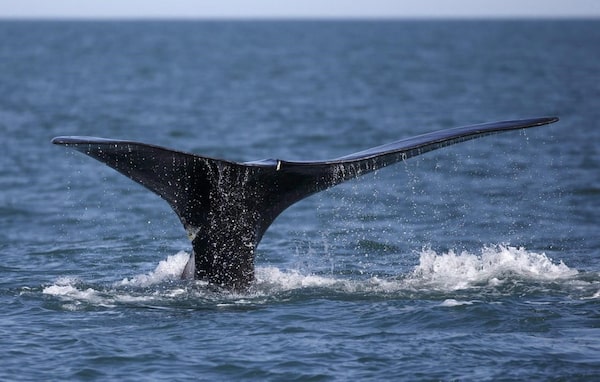
A North Atlantic right whale feeds on the surface of Cape Cod bay off the coast of Plymouth, Mass. in 2018.The Associated Press
A new network of underwater microphones that listen for the whooping call of right whales may be helping save the solitary giants’ lives in the Gulf of St. Lawrence, but they’re also forcing some fishermen to return to shore with half-empty boats.
Not a single right whale carcass or entanglement has been reported so far this season, an encouraging sign after 20 of the endangered whales were killed in the Gulf of St. Lawrence from 2017 to 2019.
Fisheries and Oceans Canada started using the microphones, called hydrophones, this season, along with other tougher protection measures in response to international pressure to save the North Atlantic right whales, which have a global population of about 450 and only around 100 females of breeding age.
Until this year, whale conservation efforts relied on visual sightings from planes or vessels to determine when a fishing area should be closed down, or if speed limits should be reduced in a shipping corridor. That’s all changed with new acoustic listening technology attached to underwater buoys and autonomous gliders that slowly travel beneath the waves, listening for the whales’ telltale sounds.
Those devices detected more than two dozen right whale sounds in the Gulf of St. Lawrence between Aug. 8 and Aug. 23, according to data from Dalhousie University’s online Whale Map.
Under federal rules, one whale detection closes the immediate fishing area for 15 days; if they’re detected more than once in the same time frame it closes the fishing area for the rest of the season because it’s considered a feeding area. That’s caused some tension between fishermen, forcing them to pull their gear and move into increasingly crowded waters – with some crab-fishing crews in northeastern New Brunswick moving their traps three times in the span of two weeks because of whales.
From a conservation point of view, early indications are the devices, supported by increased surveillance from airplanes, appear to be working. It’s a critical new tool as warming ocean waters put the endangered whales on a collision course with humans in an area where the mammals have only recently started travelling.
“The acoustic listening devices don’t care if it’s blowing 40 knots, or if it’s nighttime. Their ears essentially are open 24/7. So we have more means for detection,” said Dr. Moira Brown, a top North Atlantic right whale expert and senior scientist with the Canadian Whale Institute on Campobello Island, N.B.
Other new measures this year include mandatory marking and reporting of lost fishing gear, and a requirement that boats report any accidental collisions with whales.
The increased surveillance has an obvious downside for fisheries that share the water with the whales. In the snow crab fishery of New Brunswick’s Acadian Peninsula, where fishing is the biggest economic provider, some vessels reported significant reductions in their catches because of whale detections that triggered automatic zone closings.
“If you talk to fishermen, it’s putting enormous pressure on them. Most were not able to take all their quota this year. Some were as low as 50 per cent compared to last year,” said Jean Lanteigne, general manager of the Regional Federation of Professional Fishermen in Shippagan, N.B.
“Some fishermen are more affected than others. It was a really difficult season for some of them, and there was a lot of stress.”
Dr. Brown acknowledged that fishermen bear the brunt of conservation efforts to save the whales, and said the science around whale protection is evolving.
“The fishermen are changing their operations to make room for the right whales. They deserve all the credit in the world,” she said. “These are hard things to do. We need to work toward a balance of whales and ships, ship traffic and fishing. ...We’re striving for co-existence, and this year, so far it looks pretty good.”
Working out of sight in the Gulf of St. Lawrence, the underwater hydrophones are sending data daily to federal officials.
That data is helping inform a new, adaptable approach to fishing closings that allow officials to adjust as the whales move, Dr. Brown said. In other jurisdictions, such as the United States, static closings due to whale sightings are sometimes out of date with the reality of where the whales are travelling, she said.
Mr. Lanteigne said most fishermen understand they have an important role to play in protecting right whales. They’re trying to adapt as well, testing fishing gear that doesn’t tangle the big animals, and pushing for a later crab fishing season that puts vessels on the water after the whales migrate to warmer waters in the south.
“We have to figure this out, because you know the whales are not going to stop coming,” he said.
Our Morning Update and Evening Update newsletters are written by Globe editors, giving you a concise summary of the day’s most important headlines. Sign up today.
 Greg Mercer
Greg Mercer